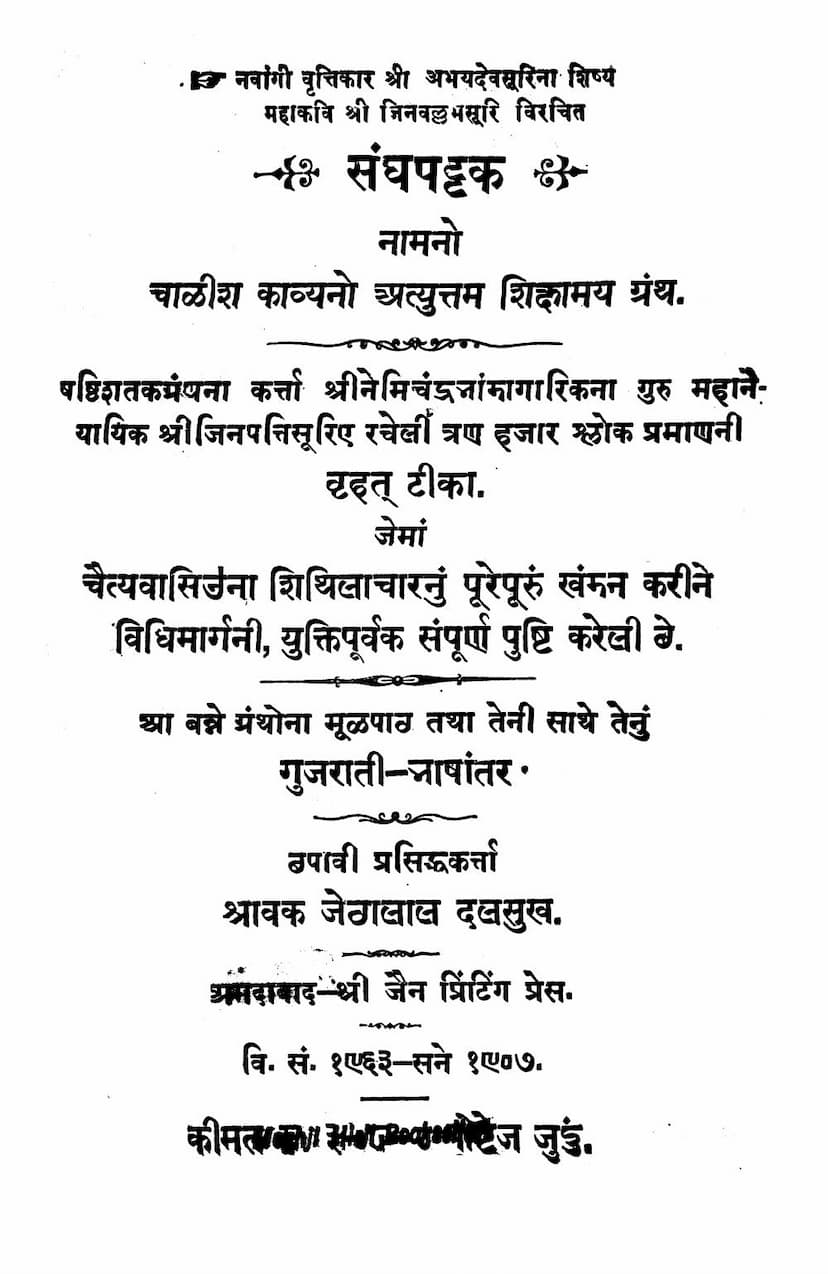Sangh Pattak 40 Kavyano Attyuttam Shikshamay Granth
Added to library: September 2, 2025

Summary
The provided text is a Gujarati introduction and commentary on the Jain text "Sangh Pattak" by Muni Jinvallabhsuri and Nemichandra Bhandagarik. The introduction provides historical context and highlights the central theme of the Sangh Pattak, which is the critique of the "Chaityavasi" (temple-dwelling) Jain monks and the advocacy for the "Vidhimarg" (rule-based path) followed by the "Vastuvasi" (monks dwelling in solitary places or forests).
Here's a breakdown of the key points from the text:
1. The "Sangh Pattak" - A Scholarly and Educational Work:
- It is described as an excellent and educational work of forty verses composed by the great poet Muni Jinvallabhsuri.
- It is presented alongside a commentary of three thousand verses by Mahayogi Jinvallabhsuri's guru, the great logician Shri Jinpatisuri, who was the author of the "Shathshatak."
2. The Core Issue: Chaityavasi vs. Vastuvasi:
- The text strongly criticizes the "Shithilachar" (laxity in practices) of the Chaityavasi monks, particularly their departure from the strict rules laid down by Lord Mahavir.
- It champions the "Vidhimarg" (rule-based path) which aligns with the original teachings and practices of the Jain monks ("Nigranth").
3. Historical Context of Jain Monasticism:
- Lord Mahavir's disciples were known as "Nigranth" (unfettered by possessions). The scriptures they followed were called "Nirbhaypravan" (fearless teaching).
- Initially, monks lived in forests outside villages, or in houses borrowed from householders when in villages. They avoided pre-prepared food (considering it "Adhikarmi"), renounced possessions, avoided conflict, and remained absorbed in meditation.
- This pure tradition continued for about a thousand years after Lord Mahavir's nirvana, guided by powerful, learned, and virtuous gurus.
4. The Rise of Chaityavasi and its Decline:
- About 750 years after Mahavir's nirvana, some ascetics became indifferent to Mahavir's teachings and began the practice of "Chaityavas" (living in temples), possibly influenced by the Bhikshu Sangha of Buddhism.
- A key figure mentioned is Devardhigani Kshamashramana, who compiled the Jain Sutras into written form about 80 years before the Common Era. His passing is seen as a turning point where the Chaityavasi sect gained more influence.
- The text describes how, over time, the Chaityavasi sect created secret texts (like "Nishad") to justify their practices, such as living in temples and accumulating wealth, contrary to the original scriptures.
- They disrespected the Vastuvasi monks and developed rival sects or "Gachhas," leading to disunity and conflict.
- The text traces the historical struggle to curb the influence of Chaityavasi, highlighting the efforts of various Acharyas like Jinavallabhsuri, Jinadattasuri, and Jinpatisuri, who used their scholarship and poetic skills to expose the flaws in Chaityavasi practices and re-establish the Vidhimarg.
- The influence of Chaityavasi waned significantly by the end of the 15th century Vikram Samvat, with the Vastuvasi tradition regaining prominence.
5. The "Sangh Pattak" as a Defense of Pure Jainism:
- Muni Jinvallabhsuri composed the Sangh Pattak (with 40 verses) to vehemently refute the Chaityavasi practices and to strengthen the faith of those who followed the pure path.
- The verses of the Sangh Pattak and related rules were inscribed on the pillars of a temple built in Chittor by influential patrons, demonstrating the work's importance in preserving the correct doctrine.
6. Key Criticisms of Chaityavasi Practices:
- Living in temples ("Chaityavas").
- Accumulating wealth and possessions.
- Deviating from strict adherence to scriptures.
- Developing personal affiliations and pride in their specific sects ("Gachhas").
- Engaging in worldly comforts and practices contrary to asceticism.
- Justifying their laxity through fabricated texts.
7. The "Gachh" Concept:
- The original meaning of "Gachh" (sect) was simply a group of monks. However, Chaityavas led to pride, attachment, and conflict over their specific Gachhas.
8. The Author's Intent:
- The text is being published with a Gujarati translation to educate people about the true Jain path and to counter the "ignorance" that has arisen, particularly among the descendants of the Acharyas who fought against Chaityavasi, who are now themselves being criticized for their own deviations (e.g., living in monasteries ("Maths") rather than following the original 'Vastuvasi' principles).
9. The "Yathaguru Tathashishya" Principle:
- The text emphasizes the "As the guru, so the disciple" principle, stating that as gurus became lax, their disciples became even more so, engaging in activities like trading and agriculture.
10. The "Sangh" Terminology:
- The introduction clarifies that the term "Sangh" originally referred to the community of monks or the four-fold Sangha (monks, nuns, laymen, laywomen), but in current times, it often refers only to the lay community. The Sangh Pattak uses "Sangh" in its broader, original meaning.
11. A Call to Righteousness:
- The text is intended to help readers find the true Jain path, uphold the principles of "Dharma," and move away from blind attachment and false reasoning. It highlights the importance of reading and reflecting on such critical texts, comparing them to "bitter medicine" that ultimately leads to good health (spiritual well-being).
In essence, the Sangh Pattak is presented as a historical and theological critique of deviations within Jain monasticism, emphasizing the restoration and adherence to the strict, rule-based path established by Lord Mahavir, and advocating for the spiritual purity and detachment of the ascetic life. The introduction aims to contextualize this important text for contemporary readers.